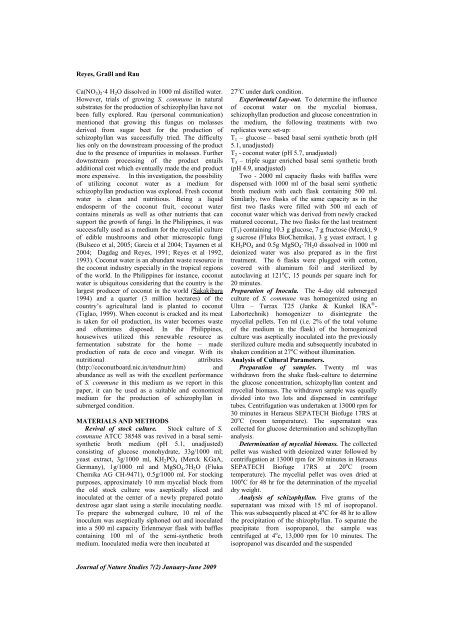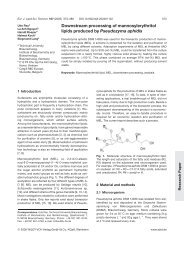COCO UT WATER AS A OVEL CULTURE MEDIUM FOR THE ...
COCO UT WATER AS A OVEL CULTURE MEDIUM FOR THE ...
COCO UT WATER AS A OVEL CULTURE MEDIUM FOR THE ...
Create successful ePaper yourself
Turn your PDF publications into a flip-book with our unique Google optimized e-Paper software.
Reyes, Graßl and Rau<br />
Ca(NO 3 ) 2·4 H 2 O dissolved in 1000 ml distilled water.<br />
However, trials of growing S. commune in natural<br />
substrates for the production of schizophyllan have not<br />
been fully explored. Rau (personal communication)<br />
mentioned that growing this fungus on molasses<br />
derived from sugar beet for the production of<br />
schizophyllan was successfully tried. The difficulty<br />
lies only on the downstream processing of the product<br />
due to the presence of impurities in molasses. Further<br />
downstream processing of the product entails<br />
additional cost which eventually made the end product<br />
more expensive. In this investigation, the possibility<br />
of utilizing coconut water as a medium for<br />
schizophyllan production was explored. Fresh coconut<br />
water is clean and nutritious. Being a liquid<br />
endosperm of the coconut fruit, coconut water<br />
contains minerals as well as other nutrients that can<br />
support the growth of fungi. In the Philippines, it was<br />
successfully used as a medium for the mycelial culture<br />
of edible mushrooms and other microscopic fungi<br />
(Bulseco et al, 2005; Garcia et al 2004; Tayamen et al<br />
2004; Dagdag and Reyes, 1991; Reyes et al 1992,<br />
1993). Coconut water is an abundant waste resource in<br />
the coconut industry especially in the tropical regions<br />
of the world. In the Philippines for instance, coconut<br />
water is ubiquitous considering that the country is the<br />
largest producer of coconut in the world (Sakakibara<br />
1994) and a quarter (3 million hectares) of the<br />
country’s agricultural land is planted to coconut<br />
(Tiglao, 1999). When coconut is cracked and its meat<br />
is taken for oil production, its water becomes waste<br />
and oftentimes disposed. In the Philippines,<br />
housewives utilized this renewable resource as<br />
fermentation substrate for the home – made<br />
production of nata de coco and vinegar. With its<br />
nutritional<br />
attributes<br />
(http://coconutboard.nic.in/tendnutr.htm) and<br />
abundance as well as with the excellent performance<br />
of S. commune in this medium as we report in this<br />
paper, it can be used as a suitable and economical<br />
medium for the production of schizophyllan in<br />
submerged condition.<br />
MATERIALS AD METHODS<br />
Revival of stock culture. Stock culture of S.<br />
commune ATCC 38548 was revived in a basal semisynthetic<br />
broth medium (pH 5.1, unadjusted)<br />
consisting of glucose monohydrate, 33g/1000 ml;<br />
yeast extract, 3g/1000 ml, KH 2 PO 4 (Merck KGaA,<br />
Germany), 1g/1000 ml and MgSO 4 .7H 2 O (Fluka<br />
Chemika AG CH-9471), 0.5g/1000 ml. For stocking<br />
purposes, approximately 10 mm mycelial block from<br />
the old stock culture was aseptically sliced and<br />
inoculated at the center of a newly prepared potato<br />
dextrose agar slant using a sterile inoculating needle.<br />
To prepare the submerged culture, 10 ml of the<br />
inoculum was aseptically siphoned out and inoculated<br />
into a 500 ml capacity Erlenmeyer flask with baffles<br />
containing 100 ml of the semi-synthetic broth<br />
medium. Inoculated media were then incubated at<br />
27 o C under dark condition.<br />
Experimental Lay-out. To determine the influence<br />
of coconut water on the mycelial biomass,<br />
schizophyllan production and glucose concentration in<br />
the medium, the following treatments with two<br />
replicates were set-up:<br />
T 1 – glucose – based basal semi synthetic broth (pH<br />
5.1, unadjusted)<br />
T 2 - coconut water (pH 5.7, unadjusted)<br />
T 3 – triple sugar enriched basal semi synthetic broth<br />
(pH 4.9, unadjusted)<br />
Two - 2000 ml capacity flasks with baffles were<br />
dispensed with 1000 ml of the basal semi synthetic<br />
broth medium with each flask containing 500 ml.<br />
Similarly, two flasks of the same capacity as in the<br />
first two flasks were filled with 500 ml each of<br />
coconut water which was derived from newly cracked<br />
matured coconut,. The two flasks for the last treatment<br />
(T 3 ) containing 10.3 g glucose, 7 g fructose (Merck), 9<br />
g sucrose (Fluka BioChemika), 3 g yeast extract, 1 g<br />
KH 2 PO 4 and 0.5g MgSO 4·7H 2 0 dissolved in 1000 ml<br />
deionized water was also prepared as in the first<br />
treatment. The 6 flasks were plugged with cotton,<br />
covered with aluminum foil and sterilized by<br />
autoclaving at 121 o C, 15 pounds per square inch for<br />
20 minutes.<br />
Preparation of Inocula. The 4-day old submerged<br />
culture of S. commune was homogenized using an<br />
Ultra – Turrax T25 (Janke & Kunkel IKA ® -<br />
Labortechnik) homogenizer to disintegrate the<br />
mycelial pellets. Ten ml (i.e. 2% of the total volume<br />
of the medium in the flask) of the homogenized<br />
culture was aseptically inoculated into the previously<br />
sterilized culture media and subsequently incubated in<br />
shaken condition at 27 o C without illumination.<br />
Analysis of Cultural Parameters.<br />
Preparation of samples. Twenty ml was<br />
withdrawn from the shake flask-culture to determine<br />
the glucose concentration, schizophyllan content and<br />
mycelial biomass. The withdrawn sample was equally<br />
divided into two lots and dispensed in centrifuge<br />
tubes. Centrifugation was undertaken at 13000 rpm for<br />
30 minutes in Heraeus SEPATECH Biofuge 17RS at<br />
20 o C (room temperature). The supernatant was<br />
collected for glucose determination and schizophyllan<br />
analysis.<br />
Determination of mycelial biomass. The collected<br />
pellet was washed with deionized water followed by<br />
centrifugation at 13000 rpm for 30 minutes in Heraeus<br />
SEPATECH Biofuge 17RS at 20 o C (room<br />
temperature). The mycelial pellet was oven dried at<br />
100 o C for 48 hr for the determination of the mycelial<br />
dry weight.<br />
Analysis of schizophyllan. Five grams of the<br />
supernatant was mixed with 15 ml of isopropanol.<br />
This was subsequently placed at 4 o C for 48 hr to allow<br />
the precipitation of the shizophyllan. To separate the<br />
precipitate from isopropanol, the sample was<br />
centrifuged at 4 o c, 13,000 rpm for 10 minutes. The<br />
isopropanol was discarded and the suspended<br />
Journal of ature Studies 7(2) January-June 2009



